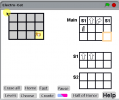Electro-Cat
Direct the cat around the grid and turn on the light panels. When you get proficient, challenge yourself to match (or better) the best performances as recorded in the hall of honor. When you are proficient with programming in Scratch, look for the personal shortcuts I programmed in and left.
I use this to introduce programming to high school students, but it would work at younger levels, too.
It is becoming more and more evident that we need to teach our students a problem-solving mindset and skills. I think that programming is the best vehicle for doing that. We need to teach every student to program some, no matter what their inclination or future is in regards to programming, specifically to equip them to solve problems. I tell them that by definition, programming involves solving problems that they don't know how to solve, and haven't been taught how to solve. I encourage them by telling them I will give them tools, but all the assignments will be problems that they don't know how to solve. The formal discussion of problem solving tools comes later, as we move to other languages.
I don't give them any help, unless they are stuck on level 5, when I may tell them to read the Help. I assign them to solve all the levels. Because there is no option to track their progress through the levels, when they solve one level, I have them perform a Save As... That way I can grade it, and they can come back later and work to solve it in fewer steps. Later I challenge them to match or better the numbers in the Hall of Honor (HoH). A final assignment requires choices of various options, including matching or bettering a set number of HoH solutions, or choosing a level and programming it so the first switch changes a blue panel to a new color and the second switch turns the light on.
To start, I give them level 1 and tell them to click on the panels in main, move the cat around and turn on the blue light panel. They are on their way to learning to solve problems. Along the way, they learn about giving logical (as opposed to random) commands. The light switch doesn't work unless the cat is on the light (blue panel).
Level 4 can be solved by using S1 and S2 as repositories for more commands, but level 5 cannot be solved except by using one of the subroutines as a true subroutine. Once they have seen this, they will forever understand subroutines and procedures, even though they may occasionally need to be reminded that "It's just like the S1 in Electro-Cat"
They come out of doing all the levels knowing that programming is problem solving and what is meant by logical progression. They value conciseness and have a visible demonstration of how subroutines function.
One caveat when you load or save it: After the window appears, it takes about a minute to parse the program, before you see anything. Be patient, it hasn't crashed.


